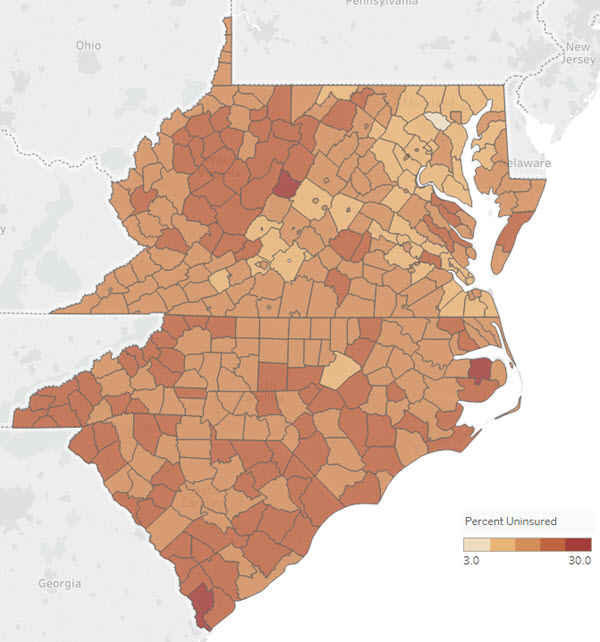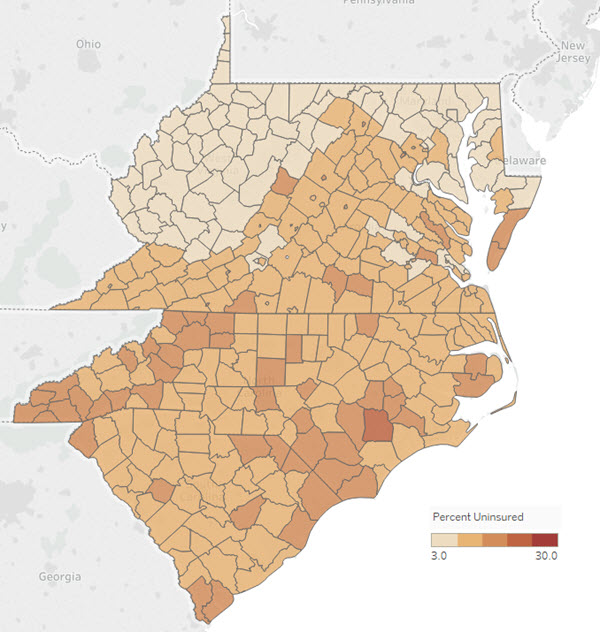Medicaid Expansion Boosts Health Insurance Coverage in Parts of Fifth District
The Affordable Care and Patient Protection Act (ACA) was passed by Congress in 2010 and attempted, broadly, to expand health insurance coverage in the United States. A major part of this effort was incentivizing states to expand eligibility for the government-funded Medicaid health plan. Among Fifth District jurisdictions, only Maryland, the District of Columbia, and West Virginia expanded Medicaid by 2016. Maryland and West Virginia expanded eligibility for people making up to 138 percent of the federal poverty level (FPL), while D.C. allowed people making up to 216 percent of the FPL to enroll in Medicaid. Over the last several years, insurance coverage in the Fifth District has increased overall, but that increase has not been evenly distributed geographically.
Every year, the U.S Census Bureau publishes its Small Area Health Insurance Estimates (SAHIE). Using data from various surveys and programs (including the American Community Survey, Medicaid, and the Supplemental Nutrition Assistance Program), SAHIE approximates the number of people under the age of 65 who currently have health insurance and provides estimates by state and county. The data series began in 2005, and the latest data available are for 2016; however, the way the data were collected was changed in 2007, which makes 2008 the earliest year available for comparison to the 2016 data.
In 2008, two years before the passage of the ACA, the Fifth District was slightly more insured than the nation as a whole with about 84.6 percent coverage compared to 83.5 percent for the U.S. The trio of Maryland, D.C, and Virginia had the highest insured rates in the District. South Carolina had the lowest rates of coverage, with nearly one in five people lacking health insurance. Even within states, there were wide differences in insurance coverage. Virginia, for example, ranged from 92.3 percent covered in Loudon County to 73.7 percent insured in Highland County. (See map below.)
By 2016, after the passage of the ACA and expansions to Medicaid, the share of the population with insurance increased in every state in the Fifth District. Specifically, the District of Columbia, West Virginia, Maryland, and Virginia each had more than 90 percent of their residents insured, with D.C. leading the way with a rate of 95.9 percent. Meanwhile, North Carolina and South Carolina increased to 87.8 percent and 87.9 percent of their residents being insured, respectively.
Despite overall increases in coverage, insured rates still varied widely within states. This was especially true in Virginia and North Carolina. In Virginia, health insurance coverage was highest in Loudon County (in Northern Virginia), where just 6.9 percent of residents were without health insurance, compared to the nearly 18 percent uninsured in Accomack County (on the Eastern Shore of Virginia). In North Carolina the best and worst performing counties were in close proximity to each other. Wake County, which contains Raleigh, had a 90.8 percent insured rate, while in nearby Duplin County (just 40 miles southwest), only 79.9 percent had health insurance.
The most striking difference between the two maps above is the increase in insurance take-up in West Virginia, where Medicaid eligibility was expanded. One possible reason for West Virginia’s remarkable success in increasing insurance coverage may be the proportion of its population with health insurance provided by the government.
Data from the Census Bureau’s American Community Survey (ACS) estimate that around 15 percent of West Virginia’s under-65 population had Medicaid alone as their health insurance in 2009, the earliest data available. By 2016, that number grew to almost 27 percent. So, West Virginia’s overall improvement in health insurance coverage was certainly buoyed by the Medicaid expansion.
Despite increases in coverage overall and some remarkable gains in states like West Virginia, there are still geographic disparities in the rates of insurance coverage, particularly in states that did not expand Medicaid. More specifically, rural areas in Virginia and in North and South Carolina still have fairly high rates of uninsured. It remains to be seen if more states will decide to expand Medicaid, or what long-term effects of the increased rates of insurance coverage will have on the health of the Fifth District’s population.
Have a question or comment about this article? We'd love to hear from you!
Views expressed are those of the authors and do not necessarily reflect those of the Federal Reserve Bank of Richmond or the Federal Reserve System.



